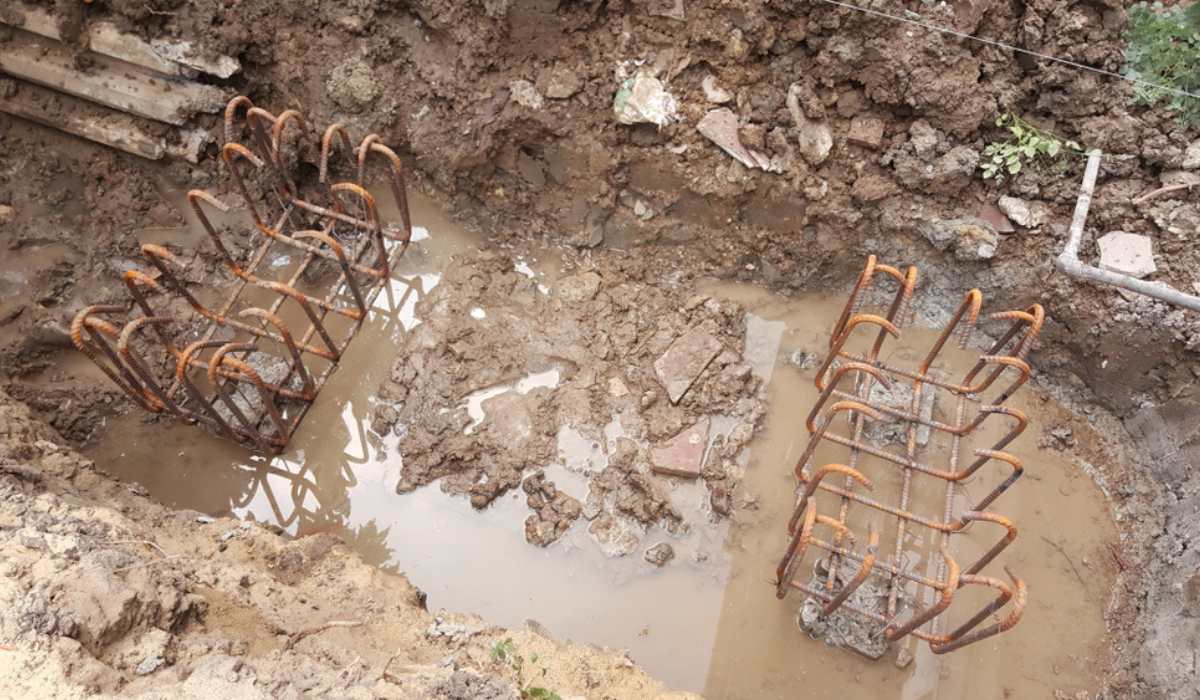In general, the footing is part of a building’s foundation that helps distribute the weight of the entire structure evenly and promotes stability. The function of the footing is to transfer the load of the building to the ground upon which it is built. They are classified into different types according to the footing’s function, quality, and weight-bearing capacity. One of the types is strap footing.
See also: Footing: Meaning, role, types, and common problems
What is strap footing?
Compound footings with additional parameters are known as strap footings. In the case of strap footing, the column’s distance from the edge is so minimal that constructors may require further excavation. So, instead of having separate footings, they are connected to a sturdy concrete bar when there is little room for the foundation.
The strap footing or strap beam is the name of this connecting bar or beam. It is used to help distribute the weight of segment footings aggressively or haphazardly placed to neighbouring foundations. The goal is to limit differential settling across sections and to have a uniform bearing pressing factor.
Strap footing: Significance
- This type of foundation combines a footing and a shallow foundation to manage the eccentricity of the load.
- The pressure distribution beneath the foundation will not be uniform if no strap beam is attached to an isolated footing loaded at the footing’s edge. There will be a triangle pressure distribution and the trim will experience a significant increase.
- If this pressure rises above the permitted bearing capacity, it can result in bearing failure.
Strap footing: Types
Strap footing transfers the bending and shear stress brought on by eccentric load to the inner column or the restraint structure. The several varieties of strap footing can be categorised according to their nature.
- Connected to the inner column via a strap beam
This one is the most popular style of strap footing foundation designed to control load eccentricity. Compared to other footing types, it is more practical. Connecting the strap beam to the inner column is more cost-effective than supporting arrangements like mass concrete blocks. Construction of the strap beam connection to the footing and internal column foundation is standard practice.
- Supporting strap beam on interior wall
There might only sometimes be nearby or perpendicular interior columns to support the strap beam. As a result, the beam must be kept with the nearest element. Civil engineers support the strap beam on the wall when there are reinforced concrete walls. The connecting detail between the beam and wall completion depends on the thickness and reinforcement arrangement of the wall.
Strap footing: Designing
Civil engineers evaluate the following list of factors before strap footing.
- Shear analysis
- Continuous stresses
- The soil pressure
- Forces’ momentum distribution
A footing with a strap is constructed between the outside balance and a neighbouring inside balance to reduce the toppling force caused by the eccentric load on the external balance.
The footing base regions are proportioned to ensure that the critical bearing elements under the two bases are equal and uniform. In this way, the centroid of the two bases’ respective territories must be traversed by the resultant of the piles on the two foundations. The ground beneath the beam must be accessible and left uncompacted so that the strap beam between the footings does not bear against the soil.

Source: Pinterest
Strap footing: Advantages
- It aids in transferring the moment to the neighbouring footing and the uniform load distribution.
- A strap footing may be acceptable when ample space between columns and a standard combined footing is unfeasible because of the extensive excavation needed.
Strap footing: Disadvantages
- The calculation of pressure bearing, pressure distribution, moment, forces, and shears can become more complicated and time-consuming in comparison.
- The complicated design of strap footing necessitates greater concentration while it is being built.
- For its construction, skilled employees are a must.
FAQs
How are strap footings designed?
They are made of two independent bases joined together by a strap beam. The strap beam is supposed to be stiff and not transfer any load by bearing on the ground at its bottom contact surface when designing a strap footing.
What purpose do straps serve in a building?
In actual structures, straps made of metals like galvanised steel are frequently used to fasten items like wall plates, joists, and rafters to stop them from lateral movement.
What kinds of strapping are there?
There are three primary varieties of strapping: Polyester/PET Strapping, Steel/Metal Strapping and Plastic Strapping.
| Got any questions or point of view on our article? We would love to hear from you.
Write to our Editor-in-Chief Jhumur Ghosh at jhumur.ghosh1@housing.com |
Housing News Desk is the news desk of leading online real estate portal, Housing.com. Housing News Desk focuses on a variety of topics such as real estate laws, taxes, current news, property trends, home loans, rentals, décor, green homes, home improvement, etc. The main objective of the news desk, is to cover the real estate sector from the perspective of providing information that is useful to the end-user.
Facebook: https://www.facebook.com/housing.com/
Twitter: https://twitter.com/Housing
Email: editor@housing.com











